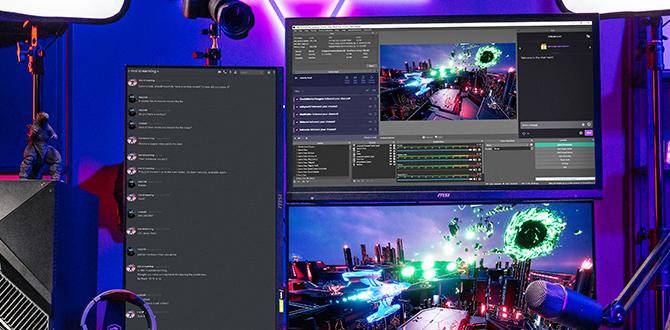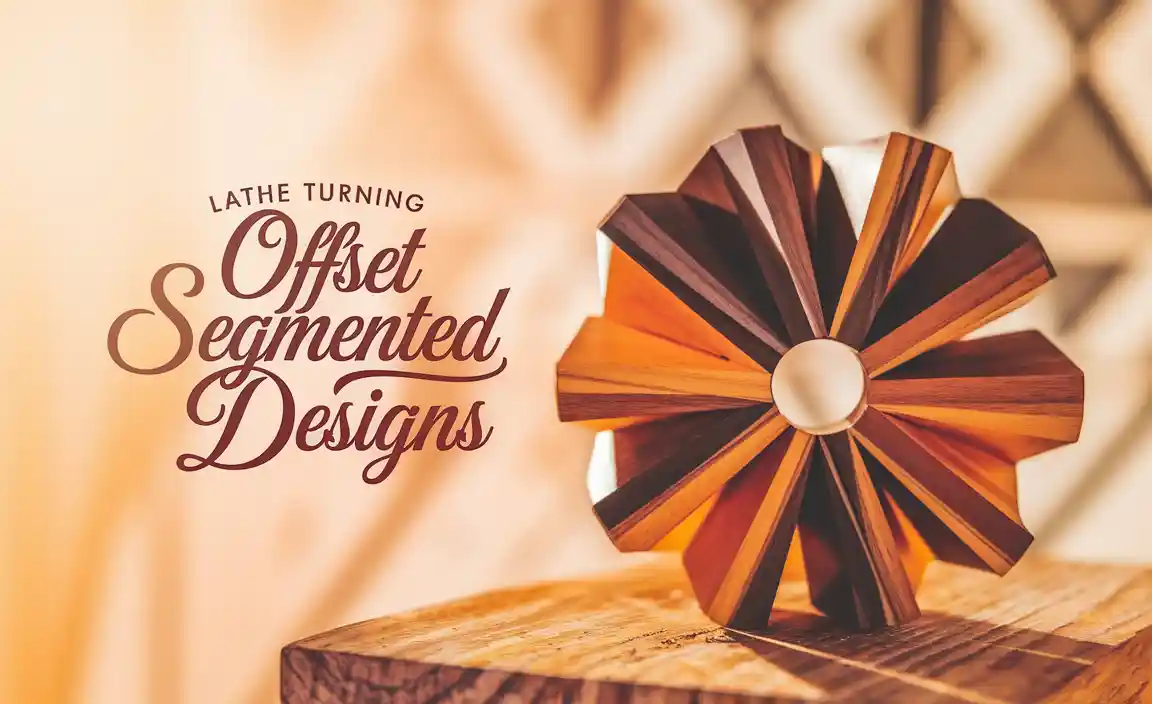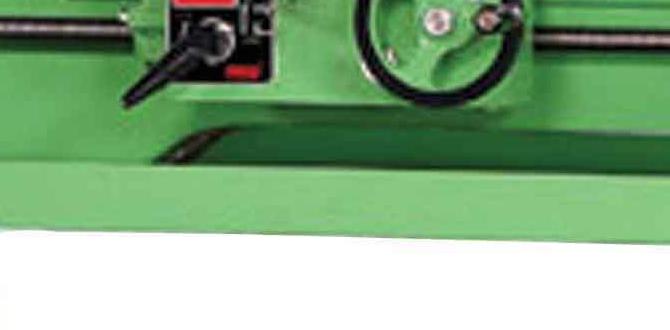Wood lathe tool sharpening mistakes can ruin your work. Learn the common pitfalls and how to fix them to get sharp, precise cuts every time. This guide ensures your tools work with you, not against you, for better results and safer operation.
Turning wood on a lathe can be incredibly rewarding. The smooth glide of a sharp chisel, the perfect curl of shavings—it’s a dance between you and the wood. But what happens when that dance turns into a struggle? Often, it’s because our wood lathe tools aren’t as sharp as they need to be. Sharpening seems straightforward, but beginners often make a few common mistakes that can lead to frustration, poor finishes, and even dangerous situations. Don’t worry, though! Like any skill, sharpening gets easier with practice and knowing what to avoid. This guide will walk you through the most frequent wood lathe tool sharpening mistakes and how to fix them, ensuring your tools are always ready for action. Let’s get those edge back where they belong so you can enjoy smooth turning again!
Why Sharp Tools Matter More Than You Think
Think of your wood lathe tools as extensions of your hands; if they’re dull, your hands get tired, and your control is compromised. Sharp tools don’t just cut; they shear wood fibers cleanly. This means less force is needed, resulting in:
- Smoother cuts and a better surface finish.
- Less tear-out and grain lifting.
- Easier tool control and greater precision.
- Reduced user fatigue and a safer turning experience.
Dull tools have to be forced through the wood. This can cause the tool to dig in unexpectedly, leading to catches and potential injuries. Plus, trying to remove material with a dull edge is like trying to spread cold butter with a blunt knife – messy and ineffective. Regular, proper sharpening is not a chore; it’s a fundamental part of successful woodturning.
Common Wood Lathe Tool Sharpening Mistakes & How to Avoid Them
Let’s dive into the specific errors many beginners make when sharpening their wood lathe tools. Understanding these will save you time, frustration, and potentially a few ruined projects.
Mistake 1: Not Sharpening Often Enough
This is probably the most common mistake of all. Many woodturners wait until a tool is noticeably dull before reaching for a sharpening stone or grinder. The problem is, by the time you notice it’s dull, you’ve likely already been fighting it and making less-than-ideal cuts.
Why it happens: It feels like an extra step, and it’s easy to get caught up in the turning process. Sometimes, beginners aren’t sure when a tool officially becomes “dull.”
The Fix: Develop a routine. Make it a habit to touch up your tools after every few significant cuts, or at least at the end of each turning session. A quick swipe on a sharpening stone or a brief touch to the grinder—just a few seconds—can maintain that razor-sharp edge much longer than waiting for it to go completely dull. Think of it as maintaining the edge, rather than restoring a lost one.
Tip: Listen to your tools. If the wood isn’t “suggesting” to the tool where to go, and you feel like you’re pushing it, it’s probably time for a quick touch-up.
Mistake 2: Overheating the Tool Steel
Using a powered grinder without care is a sure way to ruin your tool’s temper. When steel gets too hot, it loses its hardness, becoming brittle or just plain soft. This means it won’t hold an edge no matter how well you grind it.
Why it happens: Grinding too aggressively, using too much pressure, or not using enough coolant (like water) can quickly heat up the steel.
The Fix:
- Keep it cool: Dip the tool in water frequently to cool it down. Don’t let it sit on the grinding wheel for more than a couple of seconds without cooling.
- Light pressure: Let the grinder do the work. Apply only light, consistent pressure.
- Intermittent grinding: Grind for a few seconds, then cool. Repeat.
- Use a slow-speed grinder: If possible, use a slow-speed grinder (around 1750 RPM). These generate less heat than high-speed grinders (3450 RPM).
You’ll often see a slight discolouration, like a blue or purple sheen, on the steel. This is a clear sign of overheating, and you’ve likely ruined that section of the tool. If this happens, you might need to grind back past the discoloured area to regain the proper temper.
Mistake 3: Incorrect Grinding Angle
Every woodturning tool has an optimal bevel angle for its intended purpose. Grinding at the wrong angle compromises its cutting ability and can make it harder to control.
Why it happens: Guessing the angle by eye, not understanding the geometry of the tool, or not using a jig.
The Fix:
- Know your tools: Different tools (e.g., skew chisel, gouge, scraper) require different bevel angles.
- Use jigs: Invest in or make grinding jigs. These hold your tool at a consistent, correct angle for effortless grinding. Many commercial grinders have excellent jig systems.
- Practice: Even without jigs, practice observing consistent angles. However, jigs are highly recommended for beginners.
Here’s a general guide to common bevel angles:
| Tool Type | Typical Bevel Angle | Purpose |
|---|---|---|
| Spindles Gouge | 35-45 degrees | General-purpose shaping, coves, beads |
| Bowl Gouge | 50-60 degrees (deep flute) | Heavy material removal, shaping bowls |
| Roughing Gouge | 30-40 degrees | Rapid shaping of square stock to round |
| Scrapers (various) | 90 degrees (flat) or slightly burnished | Smoothing end grain or difficult grain |
| Skew Chisel | 25-45 degrees (depending on use) | Shearing cuts for fine finishing |
Remember, these are starting points. Some turners prefer slightly different angles based on their style and the wood they are working with. A good resource for detailed tool geometry is the woodturnersguild.org website, which often has diagrams and explanations for various tools.
Mistake 4: Grinding the Wrong Geometry (Edge Shape)
Beyond just the angle, the actual shape of the cutting edge matters. For instance, a gouge needs a swept-back wing for certain cuts, and a scraper needs a specific burr. Grinding a flat edge onto a gouge or failing to create a burr on a scraper makes them perform poorly.
Why it happens: Not understanding the specific geometry required for each tool type and its function.
The Fix:
- Study your tools: Learn how each tool should look when it’s properly sharpened at the cutting end. Look at examples online, in books, or at commercial tool suppliers.
- Sharpen with a purpose: When you pick up a tool to sharpen, know what shape you are trying to achieve.
- Gouges: Usually, you want a fingernail-like curve (for spindle and bowl gouges) or a straight edge with squared corners (for roughing gouges). As you grind, you sweep the tool across the grinding wheel to create this shape.
- Scrapers: The goal is to create a tiny burr or “hook” at the very edge by burnishing or scraping. This burr does the actual cutting.
For example, a common spindle gouge might have wings that sweep back at an angle, allowing for delicate shearing cuts. If you grind straight into the edge without creating these “wings” or a proper fingernail curve, it becomes a much less versatile tool, more akin to a basic scraper but less effective.
Mistake 5: Relying Solely on Grinding Wheels
Many beginners rely only on their powered grinder for all sharpening. While grinders are excellent for quickly establishing a bevel, they aren’t always ideal for the final touch-up or for certain tools.
Why it happens: Grinders are fast and seem efficient. Not realizing the limitations of a grinder for fine-tuning.
The Fix:
- Use a combination: Use your grinder (preferably slow-speed) to establish the bevel and the correct geometry. Then, use sharpening stones (water stones, oil stones, diamond stones) to refine the edge.
- Honing: After grinding, a few passes on a fine-grit stone will remove the minor burr left by the grinder and bring the edge to razor sharpness.
- Stropping: For the ultimate edge, use a leather strop with a fine abrasive compound. This further refines the edge and removes any microscopic burr, leading to a buttery-smooth cut.
A common progression is: Grinder for rough shaping -> Medium grit stone for refining bevel -> Fine grit stone for keen edge -> Strop for final polish. For tools like scrapers, stropping is often the primary way to create that effective burr.
Mistake 6: Incorrectly Creating or Removing the Burr
For many woodturning tools, especially scrapers and some chisels, a small burr at the cutting edge is crucial for sharp cutting action. Conversely, if you’re trying to achieve a clean shearing cut with a skew, you want to avoid any burr.
Why it happens: Not understanding when a burr is desired and when it’s not, or not knowing how to handle it.
The Fix:
- For sharpeners like scrapers: After grinding, you often need to create a burr. This is done by “burnishing” the edge with a hardened steel rod (a burnisher) or by using a specific scraping motion on a sharpening stone or strop. The goal is to bend a tiny sliver of metal over the edge.
- For tools requiring a keen, burr-free edge (e.g., skew chisels): After grinding, if a burr forms, it needs to be carefully removed by light honing or stropping. A burr on a skew will cause it to drag and tear rather than shear.
- Check the burr: You can often feel a burr by gently running your fingernail from behind the edge towards the cutting point. A slight “catch” indicates a burr. Be careful not to cut yourself!
Understanding this distinction is key. A scraper without a burr is a glorified piece of metal. A skew with a burr is a disaster waiting to happen.
Mistake 7: Not Honing or Stropping Properly
Even after grinding, the edge isn’t truly finished. Honing and stropping are critical for achieving and maintaining that glass-sharp cutting edge that makes turning a pleasure.
Why it happens: Thinking the grinder is enough, or not understanding the difference between honing and stropping.
The Fix:
- Honing: This involves using fine-grit sharpening stones (water, oil, or diamond) to remove the microscopic burr left by the grinder and further refine the edge. Use light pressure and maintain the correct bevel angle.
- Stropping: This is the final step. A leather strop, loaded with a fine abrasive compound (like chromium oxide or diamond paste), is used to polish and align the very fine teeth of the cutting edge. It shaves off any remaining burr and creates a mirror finish on the bevel, which translates to a glass-smooth cut in wood. Use light pressure and a dragging motion away from the edge.
For a deep dive into the physics and techniques of honing and stropping, resources like Popular Woodworking’s sharpening section offer excellent visual guides and explanations.
Mistake 8: Forgetting About Tool Balance and Ergonomics
While not strictly a sharpening mistake, improper sharpening can affect how a tool feels and handles. More importantly, if you’re not considering the balance and ergonomics of your tools, even a sharp tool can be awkward and unsafe.
Why it happens: Focus is solely on the cutting edge, not the entire tool.
The Fix:
- Handle length and fit: Ensure your tool handles are comfortable and provide good leverage and balance for the task.
- Tool weight: Heavier tools might be better for aggressive cuts (like roughing gouges), while lighter tools offer more control for detail work.
- Sharpening consistency: When you sharpen, try to maintain the tool’s original profile and balance as much as possible. Over-grinding one side can lead to an unbalanced feel.
A well-balanced, comfortable tool, even if it’s sharp, is a joy to use. An awkwardly balanced tool, even if sharp, can lead to fatigue and poor control.
Essential Tools for Proper Sharpening
You don’t need a whole workshop of sharpening gear, but a few key items will make a world of difference:
- Grinding Wheel(s): A slow-speed grinder (1750 RPM) is ideal for woodturning tools. A standard high-speed grinder can be used with caution.
- Sharpening Stones: A progression of grits is useful. A medium grit (e.g., 1000) for initial sharpening and a fine grit (e.g., 4000-8000) for honing is a good start. Diamond plates are durable and effective.
- Jigs: Angle guides or specific tool jigs for your grinder will ensure consistent bevels.
- Honing Rod/Burnisher: A carbide or steel rod for creating and maintaining a burr on scrapers.
- Leather Strop: A flat piece of leather or a dedicated stropping wheel for the final polish.
- Abrasive Buffing Compound: For use with the strop.
- Water Container: For cooling tools on the grinder.
Having these tools readily accessible near your lathe will encourage you to keep your tools in top shape.
A Step-by-Step Sharpening Process (Avoiding Mistakes)
Let’s put it all together with a generalized process that avoids the common pitfalls. This is for a typical gouge, but the principles apply broadly.
Step 1: Preparation
- Ensure your grinding wheel is clean and dressed if needed.
- Have your water bucket ready for cooling.
- If using a jig, set it up according to the tool’s recommended angle.
Step 2: Grinding the Bevel
- Hold the tool firmly, engaging the jig if used.
- Apply light, steady pressure to the grinding wheel.
- Grind for a few seconds, then remove the tool and dip it in water to cool.
- Periodically check the edge for any blue discolouration (overheating). If present, grind back past it.
- Rotate the tool to grind the opposite bevel, maintaining the same angle and pressure. Sweep the tool across the wheel to form the desired swept-back wing or fingernail shape (for gouges).
- Continue this process until the bevel is established and a small burr forms along the cutting edge on the opposite side.
Step 3: Honing (Refining the Edge)
- Switch to your sharpening stone (e.g., 1000 grit).
- Maintain the original bevel angle on the stone.
- Use light pressure and stroke the tool away from the edge, moving from the heel to the tip.
- Perform several strokes on each bevel.
- Check for the removal of the grinder’s burr.
Step 4: Stropping (Polishing and Finalizing)
- Apply a small amount of abrasive compound to your leather strop.
- Rest the tool on the strop at the same bevel angle used for grinding and honing.
- Use a dragging motion (away from the edge) across the strop. Alternate sides with light pressure.
- You can also lift the bevel slightly and use a “push” stroke on the strop for a finishing touch on some tools.
- Perform 10-20 strokes per side, or until the edge feels incredibly keen.





